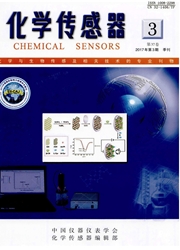

 中文摘要:
中文摘要:
理论计算和分光镜的实验显示一种三角形三结合的超分子的建筑群 CBr4XH-C,它由碳 tetrabromide,卤化物,和 protic 溶剂组成分子(指 dichloromethane,氯仿和 acetonitrile ) ,能在答案被形成。在把卤化物用作普通领受人的三角形的建筑群的卤素和氢契约的力量服从碘化物的命令 > 溴化物 > 氯化物。卤素和氢契约 weak-cooperatively 工作。在 CBr4 和卤化物之间的卤素结合建筑群的费用转移乐队在 1:1,形成常数 K 和结合的卤素的臼齿的扑灭系数的三溶剂,然后 stoichiometry 在紫外力的吸收光谱学被观察建筑群被 Benesi-Hildebrand 获得方法。K 和表演溶剂电介质常数上的依赖并且总体上,服从碘化物的一个命令 > 溴化物 > 在一样的溶剂的氯化物。而且,溶剂分子的 C-H 震动的频率与卤化物的增加显然变化,它显示 C-HX 相互作用。试验性的数据显示卤素契约和氢契约由分享由计算预言了的一个普通卤化物领受人共存。
 英文摘要:
英文摘要:
The theoretical calculation and spectroscopic experiments indicate a kind of triangular three bonding supramolecular complexes CBr4…X^-…-H-C, which consist of carbon tetrabromide, halide, and protic solvent molecule (referring to dichloromethane, chloroform and acetonitrile), can be formed in solution. The strength of halogen and hydrogen bonds in the triangular complexes using halide as common acceptor obeys the order of iodide〉bromide〉chloride. The halogen and hydrogen bonds work weak-cooperatively. Charge transfer bands of halogen bonding complexes between CBra and halide are observed in UV-Vis absorption spectroscopy in three solvents, and then the stoichiometry of 1:1, formation constants K and molar extinction coefficients ε of the halogen bonding complexes are obtained by Benesi-Hildebrand method. The K and ε show a dependence on the solvent dielectric constant and, on the whole, obey an order of iodide〉bromide〉chloride in the same solvents. Furthermore, the C-H vibrational frequencies of solvent molecules vary obviously with the addition of halide, which indicates the C-H…X- interaction. The experimental data indicate that the halogen bond and hydrogen bond coexist by sharing a common halide acceptor as predicted by calculation.
 同期刊论文项目
同期刊论文项目
 同项目期刊论文
同项目期刊论文
 Study on the kinetic properties of phosphor in deoxycholate aggregates by phosphorescent quenching m
Study on the kinetic properties of phosphor in deoxycholate aggregates by phosphorescent quenching m Chiral discrimination of quinine and quinidine based on notable room temperature phosphorescence lif
Chiral discrimination of quinine and quinidine based on notable room temperature phosphorescence lif Concentration-Dependent Br center dot center dot center dot O Halogen Bonding between Carbon Tetrabr
Concentration-Dependent Br center dot center dot center dot O Halogen Bonding between Carbon Tetrabr Investigation on solvation and protonation of meso-tetrakis(p-sulfonatophenyl)porphyrin in imidazoli
Investigation on solvation and protonation of meso-tetrakis(p-sulfonatophenyl)porphyrin in imidazoli Triethanolamine-capped CdSe quantum dots as fluorescent sensors for reciprocal recognition of mercur
Triethanolamine-capped CdSe quantum dots as fluorescent sensors for reciprocal recognition of mercur Fluorescence sensing of nitric oxide in aqueous solution by triethanolamine-modified CdSe quantum do
Fluorescence sensing of nitric oxide in aqueous solution by triethanolamine-modified CdSe quantum do Fluorescence quenching of CdSe quantum dots by nitroaromatic explosives and their relative compounds
Fluorescence quenching of CdSe quantum dots by nitroaromatic explosives and their relative compounds Studies on the effects of metal ions and counter anions on the aggregate behaviors of meso-tetrakis(
Studies on the effects of metal ions and counter anions on the aggregate behaviors of meso-tetrakis( Enantiomeric discrimination of 1,1'-binaphthol by room temperature phosphorimetry using gamma-cyclod
Enantiomeric discrimination of 1,1'-binaphthol by room temperature phosphorimetry using gamma-cyclod 期刊信息
期刊信息
